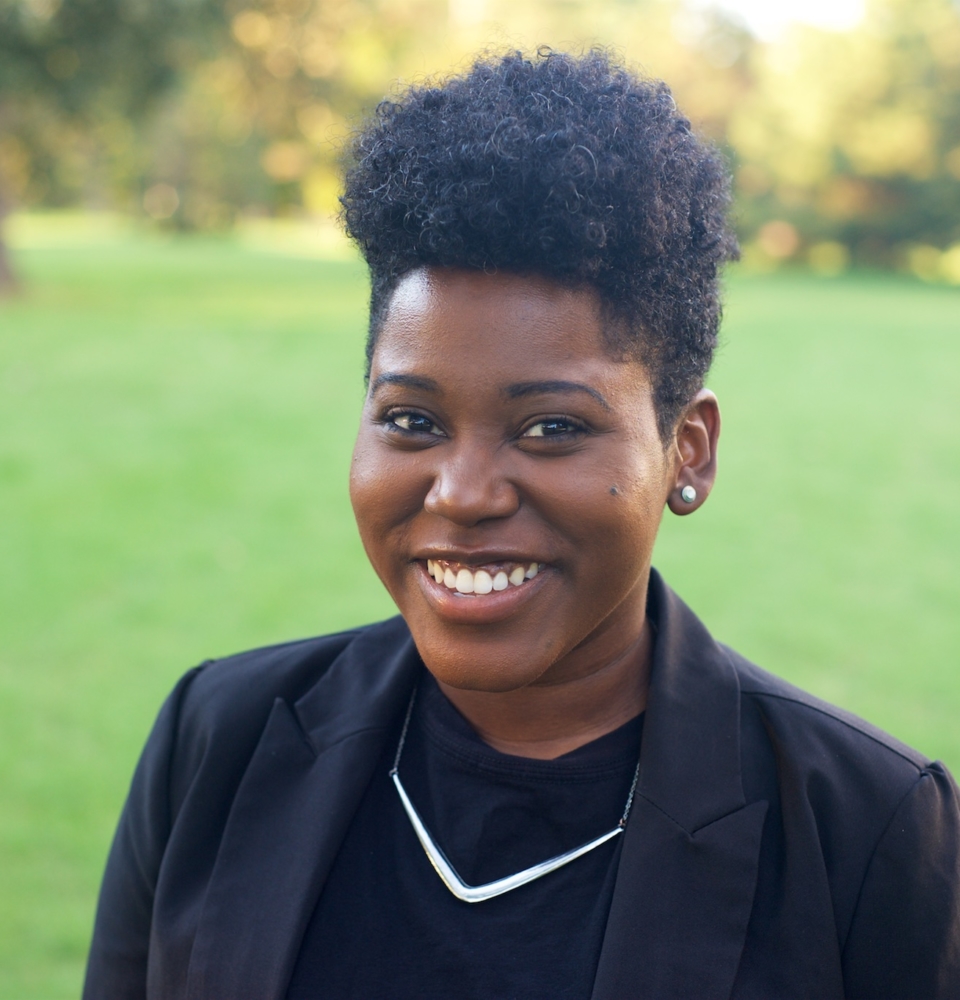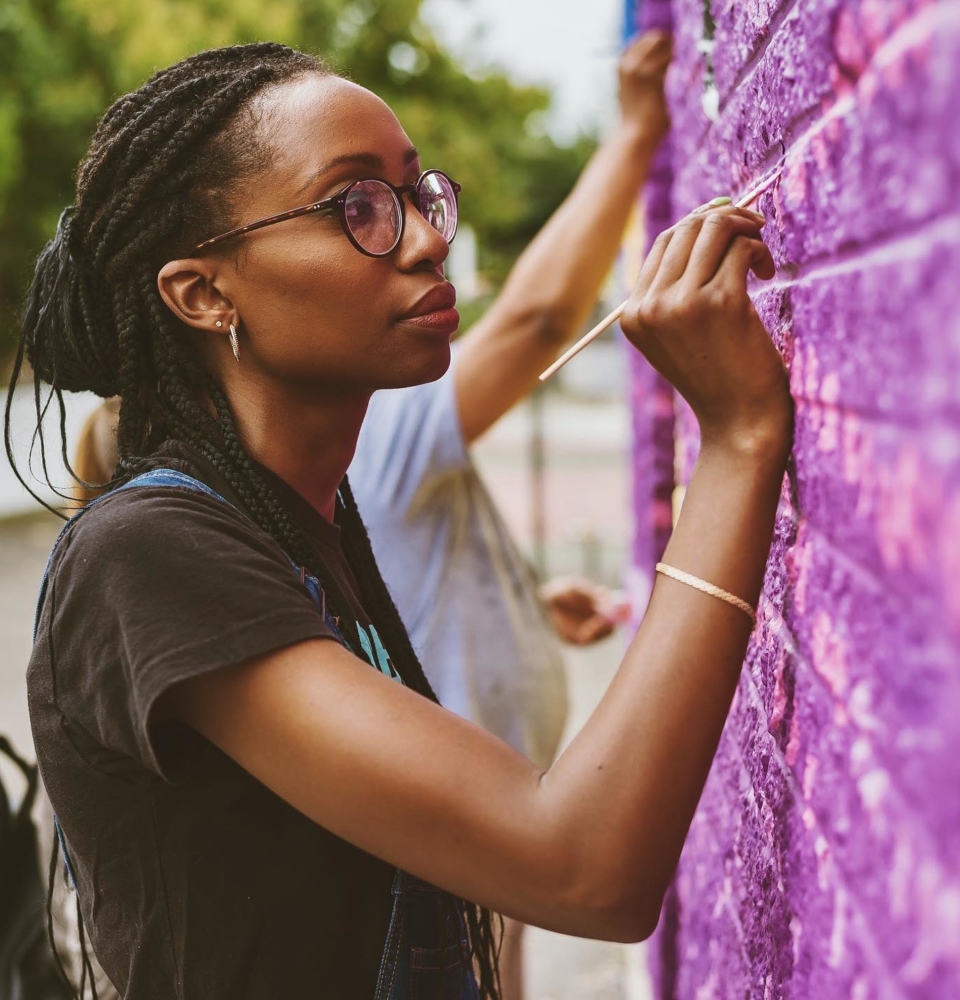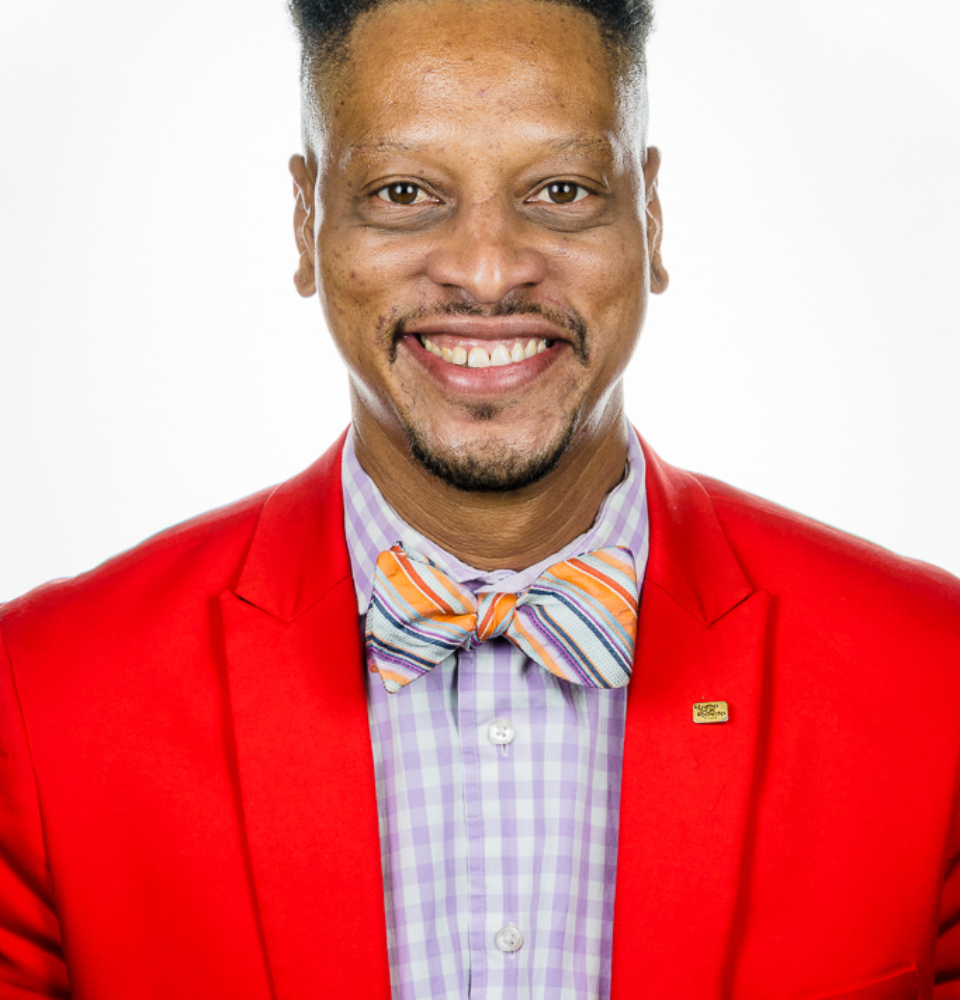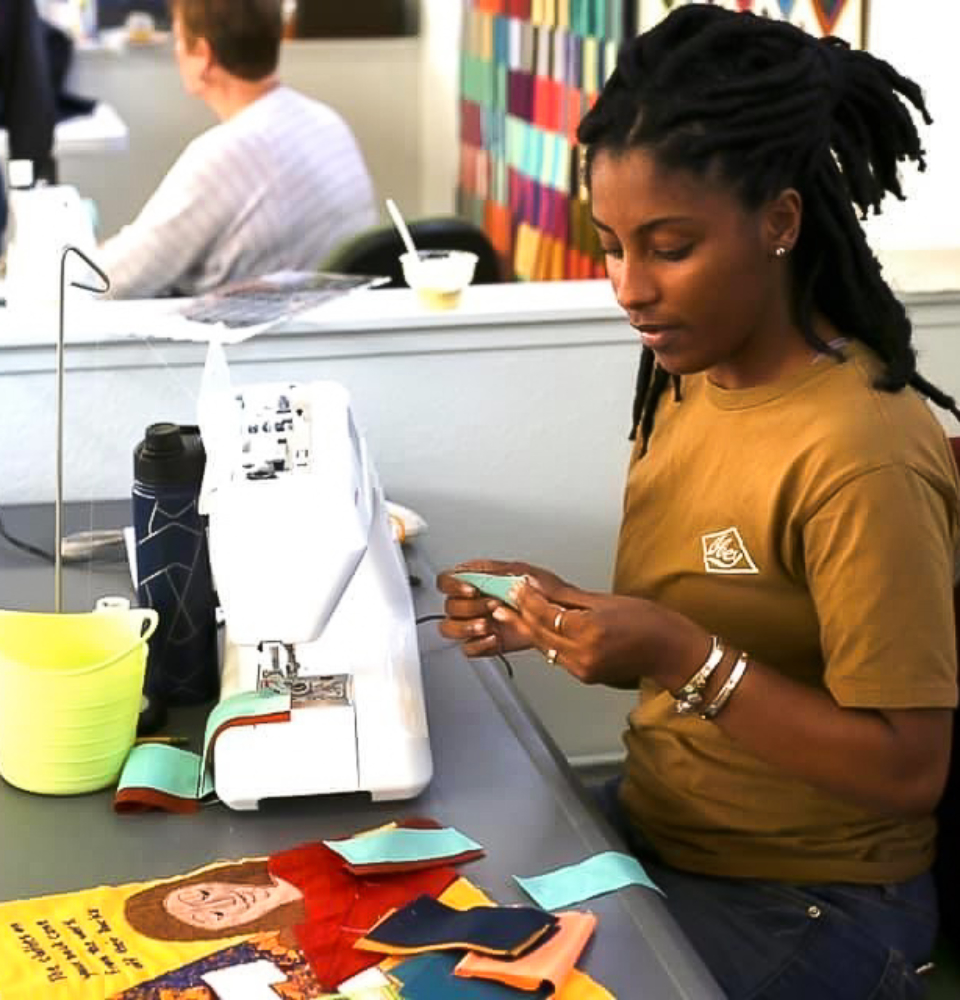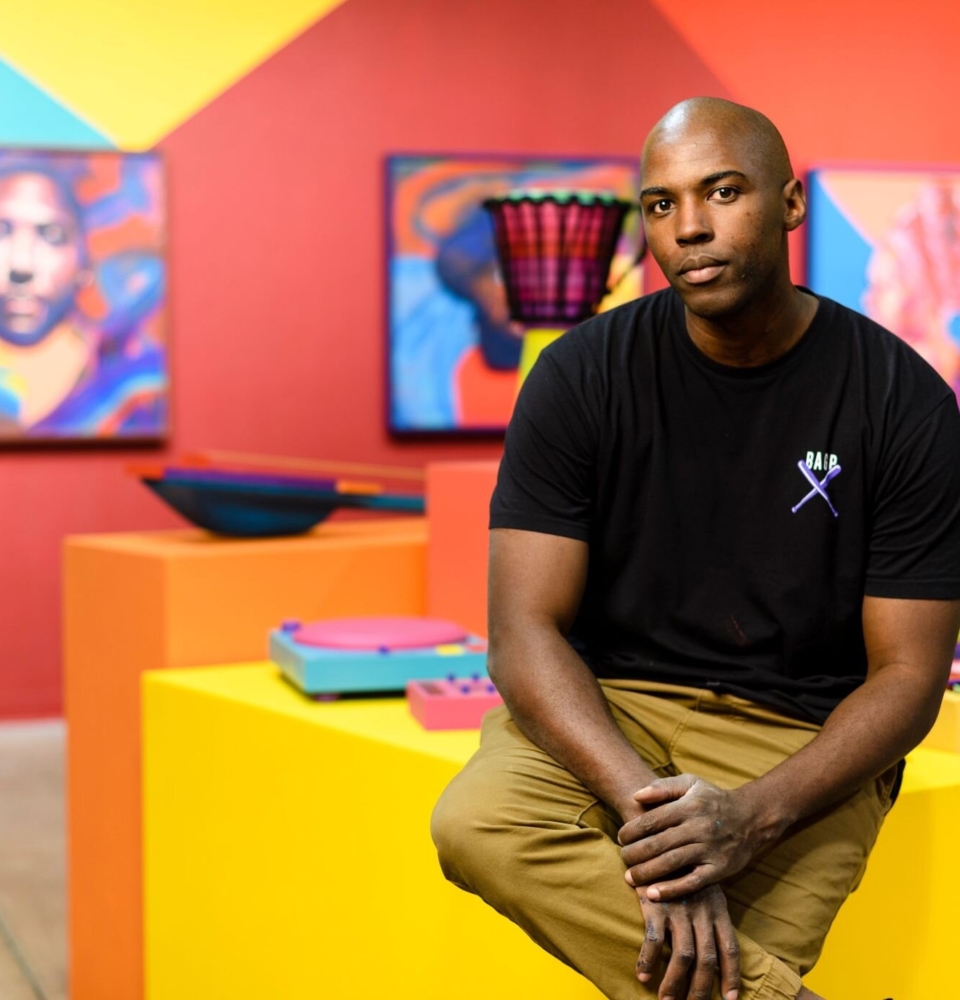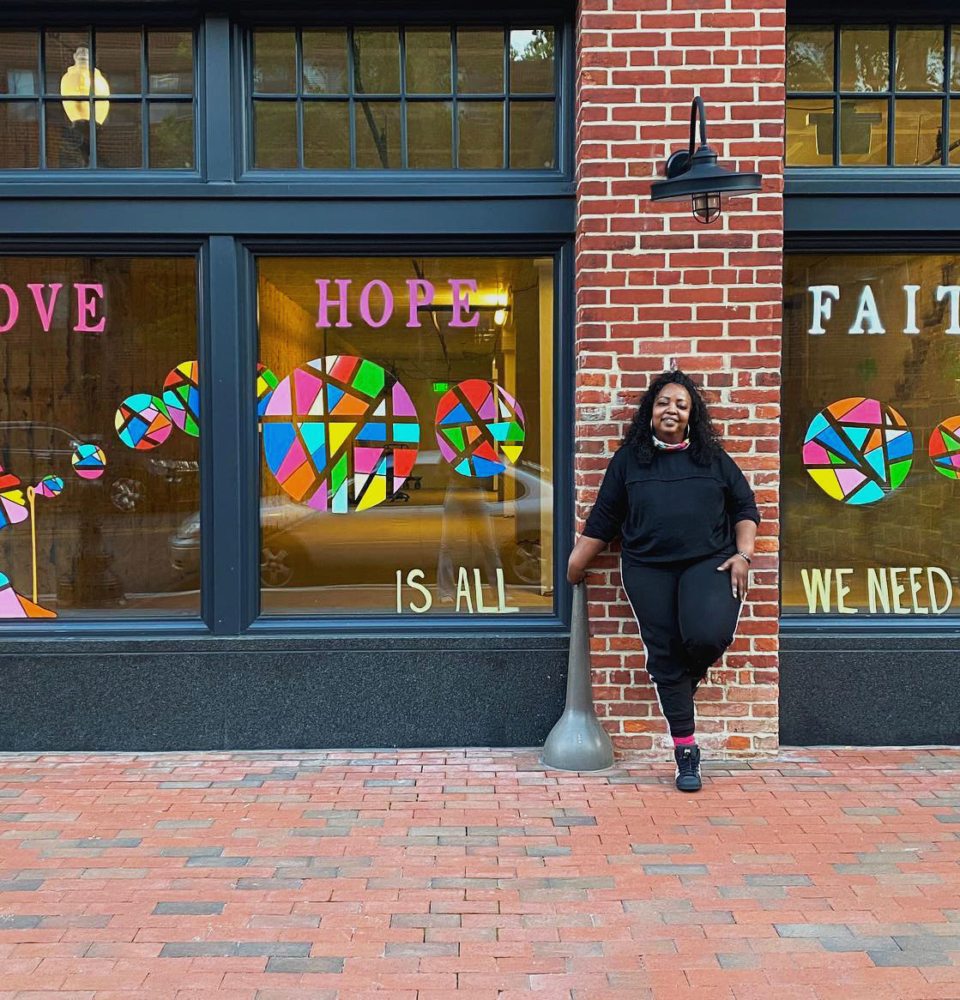As murals painted in honor of George Floyd began to appear across the globe — from Manchester, England to Idlib, Syria — they demonstrated the role street art can play in uniting a neighborhood and the world. Of course, artists have long enlisted the canvassing of buildings and businesses to amplify the change needed in their communities and painted with the intentions of enacting it. Today, in cities such as Detroit, St. Louis, and Oakland, California, buildings feature marks and murals, representative of the inspiration and dreams of their community, residents, and artists.
Through various mediums these artists document heroes and heroines, broadcast positivity, and chronicle hopes. In addition to the art emerging around the country in support of the police brutality protests, there has also been a plethora of new work in response to the coronavirus pandemic. Some artists, like Shawn Dunwoody of Rochester, New York, and De Nichols of St. Louis, believe that cities must change from a design perspective to reflect the cultural and systemic changes that both of these large-scale movements will create.
“I think people are going to tend to see a bit more creative capital due to COVID-19,” Dunwoody says. “It’s not business as usual. And so, now we have to really think creatively about messaging. We have to think about placement. When people are out, they’re going to need inspiration or guidance, or they’re gonna need color. They’re going to need things to actually drive them forward.”
Racial discrimination is starkly evident in the way that cities across the country were built. It exists through redlining, highway projects, and urban renovation programs, among other longstanding oppressive systems. But Dunwoody and Nichols and artistic initiatives like the Design Justice Network approach civic design differently as the world keeps spinning.
As a result of the institutional racism existing in every city, the path for artists of color to financial and social success provides even more obstacles. A 2018 study, conducted by mathematics professor Chad Topaz and his colleagues, showed that more than 85% of all artists on display were white and 87% were men. Mona Chalabi, a data journalist and illustrator from New York, created some infographics in The Guardian to visualize the study’s findings.
The following six featured artists are doing what they can to shake up those numbers and create exposure for Black artists. They’ve had work displayed in museums and art shows throughout the country in places including the Smithsonian in Washington, Art Basel in Miami and The National Quilt Museum in Paducah, Kentucky. And they share similar sentiments in their approaches to the business of social change through art. While these artists are creators at their roots, they also seek to actualize critical social dialogue and actionable efforts, whether by lifting up a local business’ aesthetics or chronicling the end goals of their neighbors.
“I think if you’re doing a really good job, the goal isn’t just to continue working in this area,” Nilé Livingston, a Philadelphia-based artist, says. “I think you should try to solve a problem and hopefully, eliminate the thing that you’re working against.”
De Nichols: Principal of Design and Social Practice at Civic Creatives
Artist Website | Organization Website | Instagram
Location: St. Louis, Missouri
Age: 32
Community Engagement: As a “creator in her soul,” De Nichols, who is a 2020 Loeb Fellow at the Harvard University Graduate School of Design, is one of the national organizers for #designasprotest. Originally from St. Louis, Nichols is known for her ‘Mirror Casket’ installment, which was created in collaboration with six other artists as part of the 2014 Ferguson protests after Michael Brown’s death. The piece shows how Nichols blends activism with art and has been displayed in the Smithsonian National Museum of African American History and Culture.
Though the recognition is meaningful to Nichols and the other artists, seeing the community changes they seek come to fruition would mean even more. As such, the artists invested funding from the project back into St. Louis arts and activism to assist future projects.
“[We have to] think about equity and think about the ways in which so many structures and systems have been designed unfairly, and so to do that through design is very valuable because I’m a firm believer that everything is by design,” says Nichols. “And so, some of the same methodology and thinking that goes into say, designing an ad campaign, is helping the ways in which we think about unraveling systems.”
Making Moves: Whether working on her first book, organizing national protest designs, or creating public art in St. Louis, Nichols keeps herself busy. Currently, she’s also a part of Growing Griot, which is a collaborative effort to reimagine The Griot Museum of Black History and Culture in St. Louis. Along with her company, Civic Creatives, Nichols is also a part of the Stoss team, which won a bid for Chouteau Greenway, a project meant to reimagine the city of St. Louis as more inclusive and accessible for its diverse communities.
Civic Creatives, LLC, which was founded in 2013 by Nichols and her partners, Cambrie Nelson and Emily Bornstein, started out as a nonprofit firm called Catalysts by Design. But finding that the nonprofit model made them reliant on grants and funding, they shifted the firm to an LLC in order to reinvest revenue to social initiatives.
Motivation: “It truly is about thinking through the ways that we reimagine space so that collectively we navigate and have a sense of belonging in and safety in ways that we haven’t imagined before,” Nichols says.
Through one of Nichols’ initiatives, FoodSpark, which is meant to create discussion about food access through art and dinner parties, she noticed that some of the participants came from areas considered food deserts, which lacked access to fresh food and produce. Through this discovery, she determined how she wanted to approach design.
“Projects and efforts like that just started to help me gain more clarity about how I wanted to be a designer in space and that shifted everything for me,” Nichols says.
Style: When it comes to her work, Nichols says: “There’s this balance between the sleek and the authentic.” As learned through her education in design, Nichols tries to keep her work simple and clean while keeping the message at the forefront. “Less is more, and as a communications designer, thinking about hierarchy of information and the point, like the quintessential essence of a piece – that is, for me, more important than trying to make it look the coolest,” Nichols says.
Top Tip: “Fight against mission creep and fight against imposter syndrome,” Nichols says. “Mission creep is essentially when an entrepreneur might change their narrative about what they are doing or striving for in order to get money from an investor or, if you have a nonprofit, from a foundation … You [may be] new, but you’re very capable of what you’re doing. In my case, as a young Black woman, it was like old white men in suits would intimidate me away from doing the work that I knew was needed and necessary in community spaces.”
Nilé Livingston: Muralist, graphic designer & founder of Creative Repute, LLC
Artist Website | Organization Website| Instagram
Location: Philadelphia, Pennsylvania
Age: 32
Community Engagement: As a third-generation Philadelphian, Livingston tries to fit in community engagement outside of her work as well, whether that’s working the voting polls or serving her local Walnut Hills Community Association. Much of that drive comes from seeing her family before her do the same. That includes her grandmother, who woke up each morning to help sweep the neighborhood.
Making Moves: With jobs stacking up in 2017, Livingston decided she needed help. That was when she started Creative Repute, LLC, and she’s been juggling her artwork and her business ever since. The company is a graphic design agency that works with companies, entrepreneurs, individuals, and startups to formulate a brand identity through a creative approach to business and marketing. Some clients include the NFL, Sunkist, and the Clean Air Council.
“A lot of it’s just learning as I go along,” says Livingston. “I also just watched as much information as I could on the internet, looking at other agencies, their social media, their YouTube channels, listening to people’s podcasts, and just absorbing as much as I could.”
When working with her clients, she leads with “guiding questions” to get a feel for how she can best help them reach their customers.
“It’s really strategic, asking really careful questions that the client might not fully understand,” Livingston says. “But in my head, it’s forming a picture for me or offering more direction or guidelines. And I also try to express to the client that I want their end goal to come through. So, it might not be exactly what they themselves want if they were a corporate client, but it might be what their customers might want.”
Motivation: “I think my motivation just also comes from people who have mentored me in the past and offered guidance,” Livingston says. “I just had this desire to offer that back to others. So, it’s kind of a continuum, both with my family and my grandparents and parents, and then people outside of my family who have taken me under their wing. Just being able to pay it forward.”
Style: Livingston describes her artwork as having a bright, colorful, intricate and squiggly style with drips and splatters. She likes to “transform the art so you can’t tell how it was made.”
Top Tip: “Make sure that your mission is something that you deeply believe in; something that really keeps you motivated and excited and going when you get out of bed,” Livingston says. “And I would also say, if you do take on a mission, the goal, I think, is to change the status quo if there’s something that you’re working against.”
Shawn Dunwoody: Multidisciplinary creative force for change, founder of DunwoodÉ Consulting
Artist Website | Instagram
Location: Rochester, New York
Age: 47
Community Engagement: Known throughout the city as an artist who collaborates with people residing in the communities in which he works, Dunwoody has installed public art pieces in parks and on buildings all over Rochester, New York.
In 2015, Dunwoody began the Fruit Belt Project and hired five Rochester City School District students to help him paint murals. The project, Dunwoody says, was an effort to “change the climate or idea of a neighborhood.” In the JOSANA neighborhood, which has faced long-time struggles with urban blight and poverty, Dunwoody and his artists worked with the community and a couple of local businesses, including College Club Beverages and FoodLink. Starting with the intention to create unity for the neighbors, what stood out to Dunwoody was the opportunity to work with students and serve as a mentor.
More recently, Dunwoody worked in partnership with Rochester’s Protect Your Circle project, which adds temporary artwork that advises safety practices during the COVID-19 crisis. The city of Rochester has reciprocated Dunwoody’s support, bringing him on to lead the creation of a large-scale mural on the streets of Rochester in support of Black Lives Matter.
Making Moves: Trust is a valuable aspect of Dunwoody’s arsenal because he wants residents to know that his intentions fit their own. He suggests that young artists formulate relationships with every person and entity that they can, especially urban universities, to ensure they’re creating a positive footprint in the cities in which they exist.
“It’s about developing that trust in your neighborhood, in your community, in your city and state, whatever it may be,” Dunwoody says. “And even when I do work outside of my own city and travel, I always tell folks that I’m just sort of the vehicle for your voices.”
Motivation: “Earlier on I was more of a gallery artist and lecturing, and then one of the key things that happened was I realized I wanted to be what I wanted to see when I was 15 years old,” Dunwoody says. “I didn’t see anyone doing what I wanted to do. So, I couldn’t ask, ‘How do you do what you do?’ So, I started to turn to public artwork, so people could actually see me and ask questions.”
Style: Like many artists, Dunwoody says pinpointing a style is nearly impossible. “It varies depending on what I’m doing,” he says. “Anywhere from sculpture to painting to digital design. How would I describe my work? I have no way to even answer that.”
Top Tip: “Don’t be afraid to ask people for things that you want to do,” Dunwoody says. “People don’t know what they’re looking for and don’t know how the arts intersect [their] lives.”
Sara Trail: Founder and Executive Director of Social Justice Sewing Academy
Organization Website | Instagram
Location: Antioch/Oakland, California
Age: 25
Community Engagement: The Social Justice Sewing Academy hosts workshops with marginalized youth in schools, prisons, and community centers throughout the country. The company was founded on the idea of creating tangible social change through the collaborative and artistic efforts of quilt making.
With the death of Trayvon Martin and George Zimmerman’s subsequent acquittal in 2013, Trail was inspired to use the art form she loved as a voice of activism. Through SJSA’s workshops, the students involved choose a social issue of importance and then create a quilt block to create a dialogue around it. What’s most important to Trail, however, is what comes after that. Someone from the organization, if not Trail herself, will talk with the students about creating action plans and seeing them realized.
Recently, Trail and SJSA created a project called “Quilts of Remembrance,” which will be “a textile memorial for families who have lost a loved one to violence.”
Making Moves: As a nonprofit that seeks to combine the art form of sewing with activism against systems that oppress minorities, Social Justice Sewing Academy was founded in 2017. Trail has taken her passion for sewing and turned it into an entity that reaches across the country and has had pieces featured in The National Quilt Museum.
“We’re not creating art for the sake of it looking beautiful, but we’re creating art with a message,” says Sara Trail, founder and executive director of SJSA. “And then also mutually and simultaneously equipping kids up with tools and resources and just a foundational textual framework on what these issues are, how they’re affecting their communities and possible next steps. Next goals. What are some action items?”
Through sponsored workshops, the organization asks students what social issues they care about and want to change. With education, dialogue, and collaboration, the distinctive blocks are then created and sent off to one of the more than 1,000 embroidery volunteers who finish the sewing before sending the block back to be added to the full quilt.
Motivation: Trail, who graduated from Harvard University’s Graduate School of Education, purposefully chose to utilize what can be a more affluent style of art in quiltmaking.
“There are more easily accessible art forms,” Trail says. “So, a key point with SJSA is we’re intentionally using [sewing]. And it’s not a difficult form, it’s just less accessible than others.”
Style: Trail refers to the quilt working that she and her nonprofit engage in as “art quilting.” She describes these quilts as different from standard quilts in that they aren’t to be used as a bed cover or blanket. They’re to be shown on a wall in a museum, to tell a story, and pass along a message.
Top Tip: “The key, I think, to social impact businesses, social entrepreneurship, is working in conjunction with the community you want to help,” Trail says. “Where you’re not coming in, like, ‘You guys have an issue, I’m going to fix it.’ It’s really about just listening. Sometimes the best help you could ever give is just listening and being an idea bounce-back and really doing it with the community but not for.”
Thomas Evans: Detour
Artist Website| Instagram
Location: Denver, Colorado
Age: 35
Community Engagement: Conversation is key to the approach of Thomas Evans, who goes by the artist name Detour. Through his artwork and the platform that he’s built for himself in the Denver art scene, Detour uses conversation to share knowledge and advice for the next generation of artists. Operating from a studio in Denver’s historic Five Points neighborhood, Detour recently held an interactive exhibit at RedLine Contemporary Art Center. In it, he designed a made-up band of the future, The 5 Pointers, that exists in the year 2119 alongside a city that has been reimagined through an extensive backstory.
An alumni resident of RedLine, a Denver organization that “fosters education and engagement between artists and communities to create positive social change,” Detour considers the voice of each neighborhood in his public art. He’s embraced the community of Denver, and considering his success, which has garnered him more than 70,000 Instagram followers, it’s embraced him back.
He seeks to continue being a leader and a guide for emerging artists, especially Black artists. “So, I’m always really supportive of other artists, sort of sharing the knowledge,” Detour says. “And that’s one of the reasons why I like Denver because it’s really supportive.”
Making Moves: Being raised in a nomadic military family meant that Detour was able to gather unique experiences from each stop on his path. In Denver, Detour has been making his mark since moving there to attend the University of Colorado in 2006.
He focuses on that idea of creating dialogue through his work as a way to push things forward. It was that focus that is evident through his Five Pointers exhibit, wherein the band of Black musicians evokes consideration of the neighborhood’s gentrification.
“When it comes to my murals, it’s all about, you know, community and representation,” Detour says. “So, for the most part, it’s like a conversation with color.”
Motivation: After Detour earned his MBA in 2012, he interned with an ad agency and planned to join the military before injuring his knee. A trip to Tanzania in 2014 prompted Detour to make the decision to pursue art full-time. Since then, he’s been creating art of all varieties of media, working with his community, and providing education for emerging artists through his online platforms, especially his YouTube channel. It was while living in Germany during one of his moves as a kid where Detour first started to get serious about art, according to an interview for a Westword article.
Style: Detour says that his array of work — murals, paintings, photography, interactive media — is all abstract expressionism. He began his career in the Denver art scene with the local chapter of Hip-Hop Congress. His incorporation of dance and hip-hop culture into his artwork is evident in the aforementioned band and the musically inclined, interactive pieces featured in the same exhibit and others. He also includes an exuberance of color into his work.
Top Tip: “Just start now,” Detour says. “A lot of times I’ll hear from people that are waiting on getting a website or waiting on some piece of equipment or waiting till they graduate. Whatever you want to do, whether it’s comedy, acting, sculpture, interactive technology, whatever it is, like, get started now, because the information is out there.”
Keiona Clark: Founder of DMV League of Artists
Artist Website | Organization Website | Instagram
Location: Washington, D.C.
Age: 46
Community Engagement: “I try to make it a point to somehow give back for the blessings that’s been given to me,” says Keiona Clark, curator, artist, and founder of the DMV League of Artists. “I guess I feel like I’m kind of socially responsible to do that.”
Clark works as a curator and gallery manager for the 39th Street Gallery of Gateway CDC, a nonprofit that focuses on revitalizing the U.S. Route 1 corridor. Last year, she brought a group of emerging 13 artists to the Art Basel Miami, an iconic global art fair. At Art Basel, the group occupied space in the Spectrum Miami gallery in addition to working with a local homeless shelter.
“We partnered with Arts and Humanities,” Clark says. “They sponsored three of our local artists and we had two booths in the Spectrum gallery, which is actually a big deal because Spectrum is a hard gallery to get into. And it’s not a lot of Black artists there. That’s one of the things that I try to do with the league is to mentor emerging artists.”
Making Moves: Clark began her art career after surviving stage 3b breast cancer. Her early art reflected, through dark colors and prayer, the pain and struggle of having cancer, going through chemo, and losing her father. Now that she’s doing what she loves, her work has become more colorful.
“I have a piece called Jeremiah 29:11, which is basically the prayer in the background with a portrait of me with my head down, but it’s all words,” Clark says. “And then I have one called I surrender, and it’s a man on his knees praying to God. But I look at my work now, it’s all bright, colorful, happy. So, I think your work reflects how you feel and I’m just a happy person.”
Motivation: When Clark was diagnosed with cancer, her parents dug up a storage box with some awards she had won for her art as a child. After winning her fight with cancer, she began her new career as an artist. She often portrays women in her work as a response to the discrimination she has faced from some in the world of art commissions.
“Because I’m a Black female,” Clark says. “I can’t speak for everyone. But if you’re doing something large, it has to be a male backing you, or somebody else backing you. There’s no way you can do it by yourself, in their mind.”
Style: Much of her work is portrait-style, but Clark considers herself an abstract impressionist because of her approach to creating both portraits and other images. Now that she’s a cancer survivor, Clark says that her feeling of happiness exudes through brighter colors and the recurring image of butterflies in her work.
Top Tip: “Find a network, join a network, and understand that, as an artist, it is okay,” Clark says. “If I’m not the smartest person in the room, I don’t need to be. So, I’m okay with learning. That’s how you can learn to take criticism. Find an art family, if you can. Network your art, you know, the sales will come if you align yourself with the right people and the right situations.”
Featured image courtesy of Thomas “Detour” Evans.

